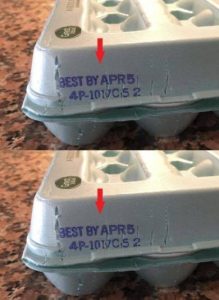We’ve all had that moment – you go to crack an egg and instantly get hit with that unmistakable, awful smell. It’s a quick reminder that not all eggs are as fresh as they seem. But instead of relying on your nose every time, you can use the little-known codes printed on egg cartons and shells to figure out their true freshness. These numbers might look random, but they actually tell you a lot about when and where your eggs were packaged. Understanding these codes can help you pick the freshest eggs and avoid any unpleasant surprises in your kitchen.

Eggs are a true staple in American kitchens. Whether you’re frying them sunny-side-up, scrambling them for breakfast, poaching them for a fancy brunch, or baking them into your favorite dessert, eggs are versatile and full of protein. But when you’re shopping for eggs, you’ve probably noticed a series of numbers printed on the side of the carton. Besides the sell-by date, there’s a special code known as the Julian date. This code is key to understanding how fresh the eggs really are.
The Julian date is a three-digit number that indicates the exact day the eggs were packaged. It’s a simple system that starts with 001 for January 1st and ends with 365 for December 31st. For instance, if the number says 045, that means the eggs were packed on February 14th. This is different from the expiration date and gives you a more accurate idea of how fresh your eggs are. Many people overlook this number, but if you want the best quality, it’s one of the most important things to check when buying eggs.
Next to the Julian date, you’ll usually find another number that starts with a “P” followed by four digits. This is the plant code, which tells you where the eggs were processed and packed. While this might not seem useful at first, it becomes important during recalls. If there’s ever a concern about contamination or safety, you can use the plant code to check whether the eggs you bought are part of the recall. The FDA’s Egg Safety website allows you to search by plant code, which helps you stay informed and safe.
Understanding both the Julian date and plant code gives you more control over the quality of the eggs you bring home. Eggs are typically at their best for about four to five weeks after packaging. However, they can still be sold for up to 30 days after that date. That means a carton with a valid sell-by date could actually be several weeks old. To get the freshest eggs, look for cartons with the highest Julian number available and check how close that number is to the sell-by date. The closer they are, the fresher the eggs. Ideally, you want to buy eggs within just a few days of packaging to enjoy the best taste and texture.
As eggs age, they go through a few noticeable changes. They don’t become unsafe overnight, but their quality slowly declines. Moisture and carbon dioxide escape through the shell over time, which causes the yolk to become more fragile and the whites to get thinner and runnier. Older eggs are also more prone to contamination, especially if they haven’t been stored properly. For recipes that rely on the structure of the egg—like omelets, meringues, or soufflés—freshness makes a big difference. Fresh eggs hold their shape better, taste better, and perform better in both cooking and baking.
Storing your eggs correctly is just as important as picking out the freshest ones. Always keep eggs in their original carton. Not only does this protect them from getting cracked, but it also prevents them from absorbing strong odors from other foods in your fridge. Store eggs in the coldest part of your refrigerator—not in the door, where the temperature fluctuates every time you open it. Use them within three to five weeks of purchase for the best flavor and texture.
If you’re ever unsure about whether an egg is still good, there are two simple tests you can try at home. The float test is a classic: fill a bowl with water and gently drop the egg in. Fresh eggs will sink and lay flat on the bottom. Slightly older ones will stand upright but not float. If an egg floats to the top, that’s a sign that it has too much air inside and is probably no longer safe to eat. You can also try the crack test. Crack the egg into a separate bowl—fresh eggs have firm, round yolks and thick whites, while older ones will look flatter and more watery. If anything smells off, trust your nose and throw it out.
When shopping for eggs, there are a few extra tips to keep in mind. Buy eggs from a refrigerated section only. Check the carton for any cracks or visible dirt. Clean, intact eggs are safer and have a longer shelf life. Look for the USDA Grade shield on the carton—that mark means the eggs meet high standards for cleanliness and quality. And don’t overstock. It’s better to buy only what you need so you’re not stuck with a carton of eggs that’s nearing the end of its shelf life.
But what if you do end up with too many eggs that are about to expire? Don’t let them go to waste. Use them up in tasty recipes. Try making a quiche—it’s savory, cheesy, and great for brunch. Or whip up some shakshuka with eggs poached in a spiced tomato sauce. Homemade pasta uses a lot of eggs and tastes amazing. Breakfast burritos, pound cake, crème brûlée, French toast, soufflé, and egg muffins are all great options, too. These dishes are delicious ways to use older eggs before they go bad.
So next time you’re in the grocery store, take a moment to check the Julian date, the plant code, and the overall condition of the carton. It only takes a few seconds, but it can save you from a bad batch and ensure you’re getting the freshest, best-tasting eggs for your family. Now that you know how to read the hidden codes on egg cartons, go ahead and spread the word—your friends will thank you for it!





